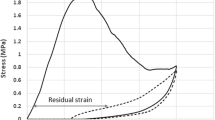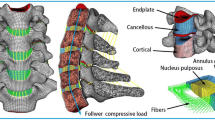Abstract
Introduction
Vertebral deformities often occur in patients who recall no trauma, and display no evident fracture on radiographs. We hypothesise that vertebral deformity can occur by a gradual creep mechanism which is accelerated following minor damage. “Creep” is continuous deformation under constant load.
Materials and methods
Forty-five thoracolumbar spine motion segments were tested from cadavers aged 42–92 years. Vertebral body areal BMD was measured using DXA. Specimens were compressed at 1 kN for 30 min, while creep in each vertebral body was measured using an optical MacReflex system. After 30 min recovery, each specimen was subjected to a controlled overload event which caused minor damage to one of its vertebrae. The creep test was then repeated.
Results
Vertebral body creep was measurable in specimens with BMD <0.5 g/cm2. Creep was greater anteriorly than posteriorly (p < 0.001), so that vertebrae gradually developed a wedge deformity. Compressive overload reduced specimen height by 2.24 mm (STD 0.77 mm), and increased vertebral body creep by 800 % (anteriorly), 1,000 % (centrally) and 600 % (posteriorly). In 34 vertebrae with complete before-and-after data, anterior wedging occurring during the 1st creep test averaged 0.07° (STD 0.17°), and in the 2nd test (after minor damage) it averaged 0.79° (STD 1.03°). The increase was highly significant (P < 0.001). Vertebral body wedging during the 2nd creep test was proportional to the severity of damage, as quantified by specimen height loss during the overload event (r 2 = 0.51, p < 0.001, n = 34).
Conclusions
Minor damage to an old vertebral body, even if it is barely discernible on radiographs, can accelerate creep to such an extent that it makes a substantial contribution to vertebral deformity.






Similar content being viewed by others
References
Burger H, Van Daele PL, Grashuis K, Hofman A, Grobbee DE et al (1997) Vertebral deformities and functional impairment in men and women. J Bone Miner Res 12:152–157
Ettinger B, Black DM, Nevitt MC, Rundle AC, Cauley JA et al (1992) Contribution of vertebral deformities to chronic back pain and disability. The Study of Osteoporotic Fractures Research Group. J Bone Miner Res 7:449–456
Grados F, Fechtenbaum J, Flipon E, Kolta S, Roux C et al (2009) Radiographic methods for evaluating osteoporotic vertebral fractures. Jt Bone Spine 76:241–247
Jiang G, Luo J, Pollintine P, Dolan P, Adams MA et al (2010) Vertebral fractures in the elderly may not always be “osteoporotic”. Bone 47:111–116
Ismail AA, Cooper C, Felsenberg D, Varlow J, Kanis JA, European Vertebral Osteoporosis Study Group et al (1999) Number and type of vertebral deformities: epidemiological characteristics and relation to back pain and height loss. Osteoporos Int 9:206–213
Rao RD, Singrakhia MD (2003) Painful osteoporotic vertebral fracture. Pathogenesis, evaluation, and roles of vertebroplasty and kyphoplasty in its management. J Bone Jt Surg Am 85-A:2010–2022
Cortet B, Roches E, Logier R, Houvenagel E, Gaydier-Souquieres G et al (2002) Evaluation of spinal curvatures after a recent osteoporotic vertebral fracture. Jt Bone Spine 69:201–208
Weinstein JN (2009) Balancing science and informed choice in decisions about vertebroplasty. N Engl J Med 361:619–621
Jager PL, Jonkman S, Koolhaas W, Stiekema A, Wolffenbuttel BH et al (2011) Combined vertebral fracture assessment and bone mineral density measurement: a new standard in the diagnosis of osteoporosis in academic populations. Osteoporos Int 22(4):1059–1068
Yamamoto E, Paul Crawford R, Chan DD, Keaveny TM (2006) Development of residual strains in human vertebral trabecular bone after prolonged static and cyclic loading at low load levels. J Biomech 39:1812–1818
Currey JD (1965) Anelasticity in bone and echinoderm skeletons. J Exp Biol 43:279–292
Zilch H, Rohlmann A, Bergmann G, Kolbel R (1980) Material properties of femoral cancellous bone in axial loading. Part II: Time dependent properties. Arch Orthop Trauma Surg 97:257–262
Burgers TA, Lakes RS, Garcia-Rodriguez S, Piller GR, Ploeg HL (2009) Post-yield relaxation behavior of bovine cancellous bone. J Biomech 42:2728–2733
Pollintine P, Luo J, Offa-Jones B, Dolan P, Adams MA (2009) Bone creep can cause progressive vertebral deformity. Bone 45:466–472
Pollintine P, van Tunen MS, Luo J, Brown MD, Dolan P et al (2010) Time-dependent compressive deformation of the ageing spine: relevance to spinal stenosis. Spine (Phila Pa 1976) 35:386–394
Adams MA, Dolan P, Hutton WC (1986) The stages of disc degeneration as revealed by discograms. J Bone Jt Surg [Br] 68:36–41
Adams MA, Roughley PJ (2006) What is intervertebral disc degeneration, and what causes it? Spine 31:2151–2161
McMillan DW, Garbutt G, Adams MA (1996) Effect of sustained loading on the water content of intervertebral discs: implications for disc metabolism. Ann Rheum Dis 55:880–887
Sato K, Kikuchi S, Yonezawa T (1999) In vivo intradiscal pressure measurement in healthy individuals and in patients with ongoing back problems. Spine 24:2468–2474
Brinckmann P, Biggemann M, Hilweg D (1989) Prediction of the compressive strength of human lumbar vertebrae. Clin Biomech 4(Suppl 2):S1–S27
Zhao F, Pollintine P, Hole BD, Dolan P, Adams MA (2005) Discogenic origins of spinal instability. Spine 30:2621–2630
Green TP, Allvey JC, Adams MA (1994) Spondylolysis. Bending of the inferior articular processes of lumbar vertebrae during simulated spinal movements. Spine 19:2683–2691
Dolan P, Earley M, Adams MA (1994) Bending and compressive stresses acting on the lumbar spine during lifting activities. J Biomech 27:1237–1248
Zhao FD, Pollintine P, Hole BD, Adams MA, Dolan P (2009) Vertebral fractures usually affect the cranial endplate because it is thinner and supported by less-dense trabecular bone. Bone 44:372–379
Adams MA, Pollintine P, Tobias JH, Wakley GK, Dolan P (2006) Intervertebral disc degeneration can predispose to anterior vertebral fractures in the thoracolumbar spine. J Bone Miner Res 21:1409–1416
Luo J, Bertram W, Sangar D, Adams MA, Annesley-Williams DJ et al (2010) Is kyphoplasty better than vertebroplasty in restoring normal mechanical function to an injured spine? Bone 46:1050–1057
Bowman SM, Gibson LJ, Hayes WC, McMahon TA (1999) Results from demineralized bone creep tests suggest that collagen is responsible for the creep behavior of bone. J Biomech Eng 121:253–258
Rimnac CM, Petko AA, Santner TJ, Wright TM (1993) The effect of temperature, stress and microstructure on the creep of compact bovine bone. J Biomech 26:219–228
van der Veen AJ, Mullender MG, Kingma I, Van Deen JH, Smit TH (2008) Contribution of vertebral bodies, endplates, and intervertebral discs to the compression creep of spinal motion segments. J Biomech 41:1260–1268
Bowman SM, Keaveny TM, Gibson LJ, Hayes WC, McMahon TA (1994) Compressive creep behavior of bovine trabecular bone. J Biomech 27:301–310
van der Veen AJ, van Dieen JH, Nadort A, Stam B, Smit TH (2007) Intervertebral disc recovery after dynamic or static loading in vitro: Is there a role for the endplate? J Biomech 40:2230–2235
Nicolella DP, Moravits DE, Gale AM, Bonewald LF, Lankford J (2006) Osteocyte lacunae tissue strain in cortical bone. J Biomech 39:1735–1743
Zioupos P, Hansen U, Currey JD (2008) Microcracking damage and the fracture process in relation to strain rate in human cortical bone tensile failure. J Biomech 41:2932–2939
Norman TL, Little TM, Yeni YN (2008) Age-related changes in porosity and mineralization and in-service damage accumulation. J Biomech 41:2868–2873
Fleck C, Eifler D (2003) Deformation behaviour and damage accumulation of cortical bone specimens from the equine tibia under cyclic loading. J Biomech 36:179–189
Caler WE, Carter DR (1989) Bone creep-fatigue damage accumulation. J Biomech 22:625–635
Mercer C, He MY, Wang R, Evans AG (2006) Mechanisms governing the inelastic deformation of cortical bone and application to trabecular bone. Acta Biomater 2:59–68
Morgan EF, Bayraktar HH, Yeh OC, Majumdar S, Burghardt A et al (2004) Contribution of inter-site variations in architecture to trabecular bone apparent yield strains. J Biomech 37:1413–1420
Adams MA, McNally DS, Dolan P (1996) ‘Stress’ distributions inside intervertebral discs. The effects of age and degeneration. J Bone Jt Surg Br 78:965–972
Briggs AM, Wrigley TV, van Dieen JH, Phillips B, Lo SK et al (2006) The effect of osteoporotic vertebral fracture on predicted spinal loads in vivo. Eur Spine J 15:1785–1795
Lynch JA, Silva MJ (2008) In vivo static creep loading of the rat forelimb reduces ulnar structural properties at time-zero and induces damage-dependent woven bone formation. Bone 42:942–949
Adams MA, McNally DS, Chinn H, Dolan P (1994) Posture and the compressive strength of the lumbar spine. Clin Biomech 9:5–14
Acknowledgments
This study was funded in the UK by Action Medical Research and the Annett Charitable Trust.
Conflict of interest
None of the authors has any potential conflict of interest.
Ethics approval
This study was approved by Frenchay NHS Research Ethics Committee, Bristol, UK
Author information
Authors and Affiliations
Corresponding author
Rights and permissions
About this article
Cite this article
Luo, J., Pollintine, P., Gomm, E. et al. Vertebral deformity arising from an accelerated “creep” mechanism. Eur Spine J 21, 1684–1691 (2012). https://doi.org/10.1007/s00586-012-2279-y
Received:
Revised:
Accepted:
Published:
Issue Date:
DOI: https://doi.org/10.1007/s00586-012-2279-y




